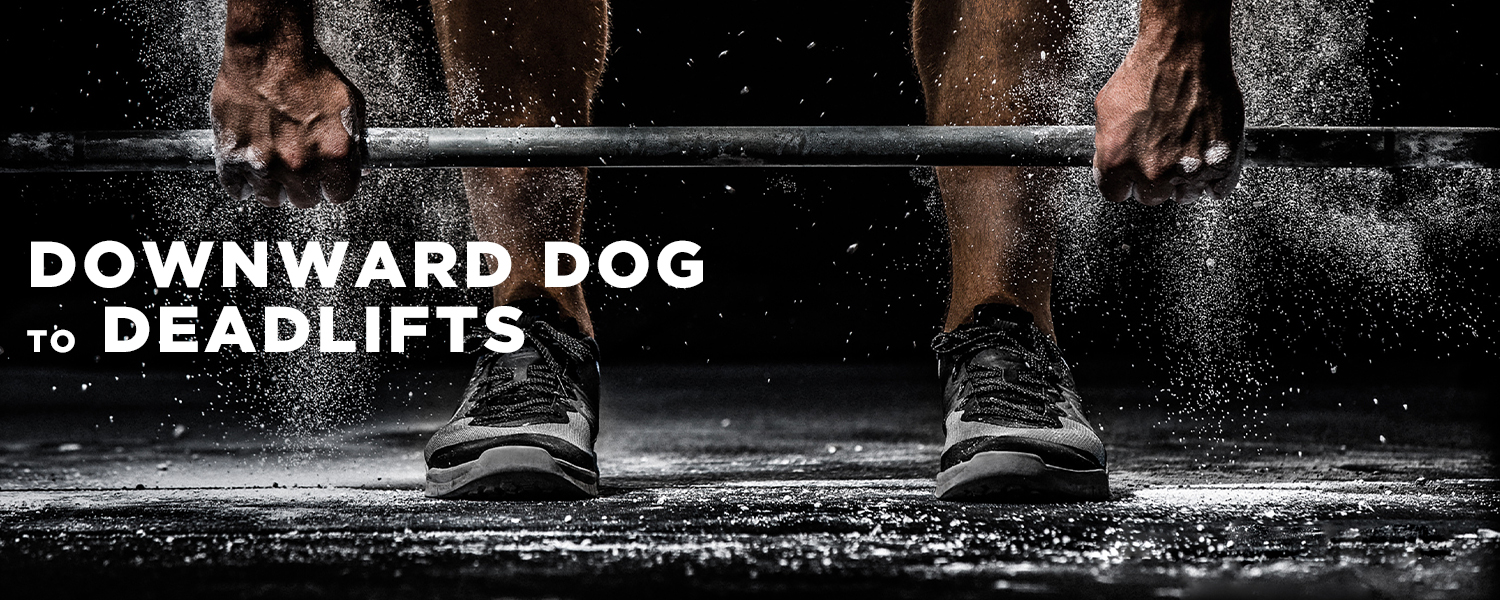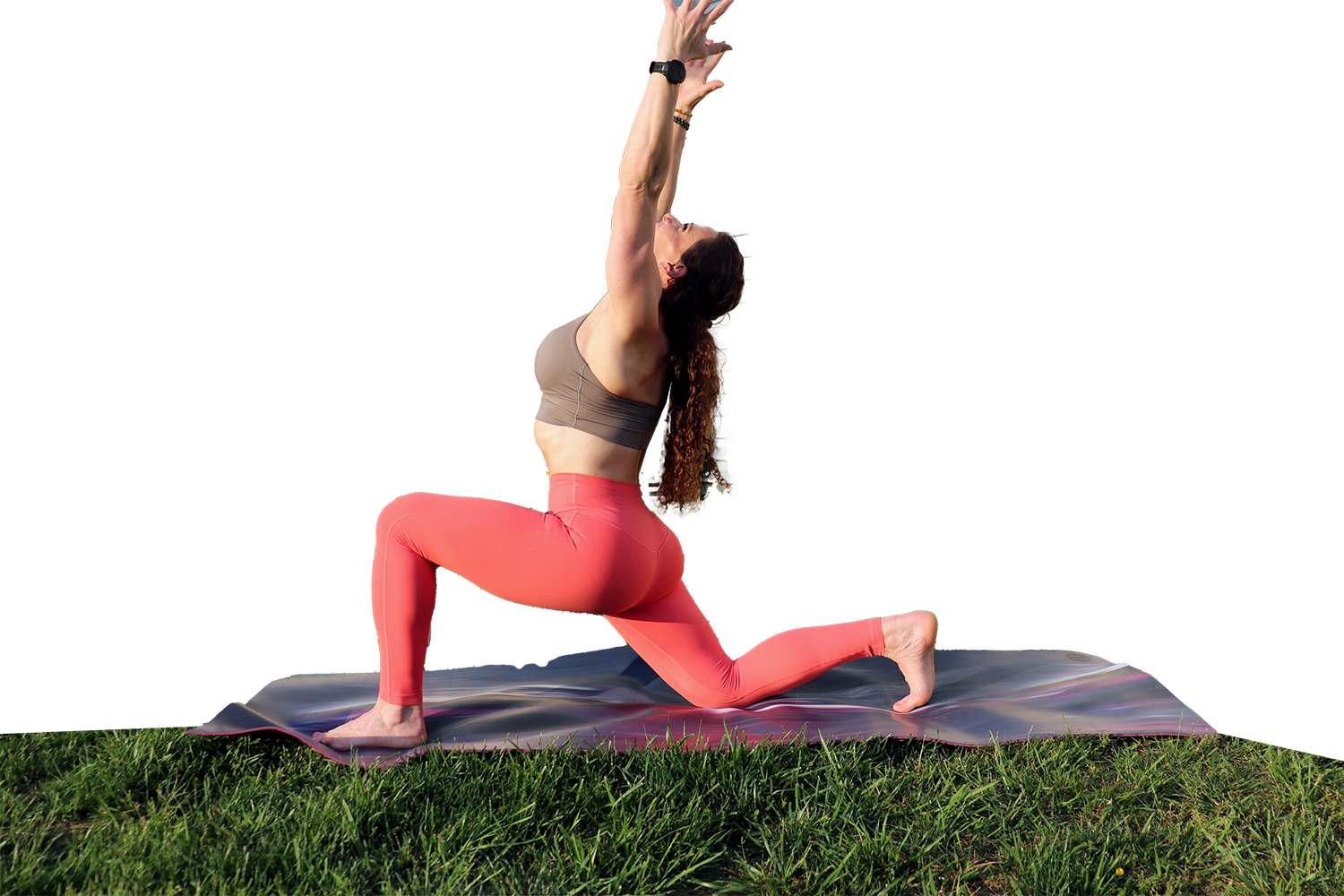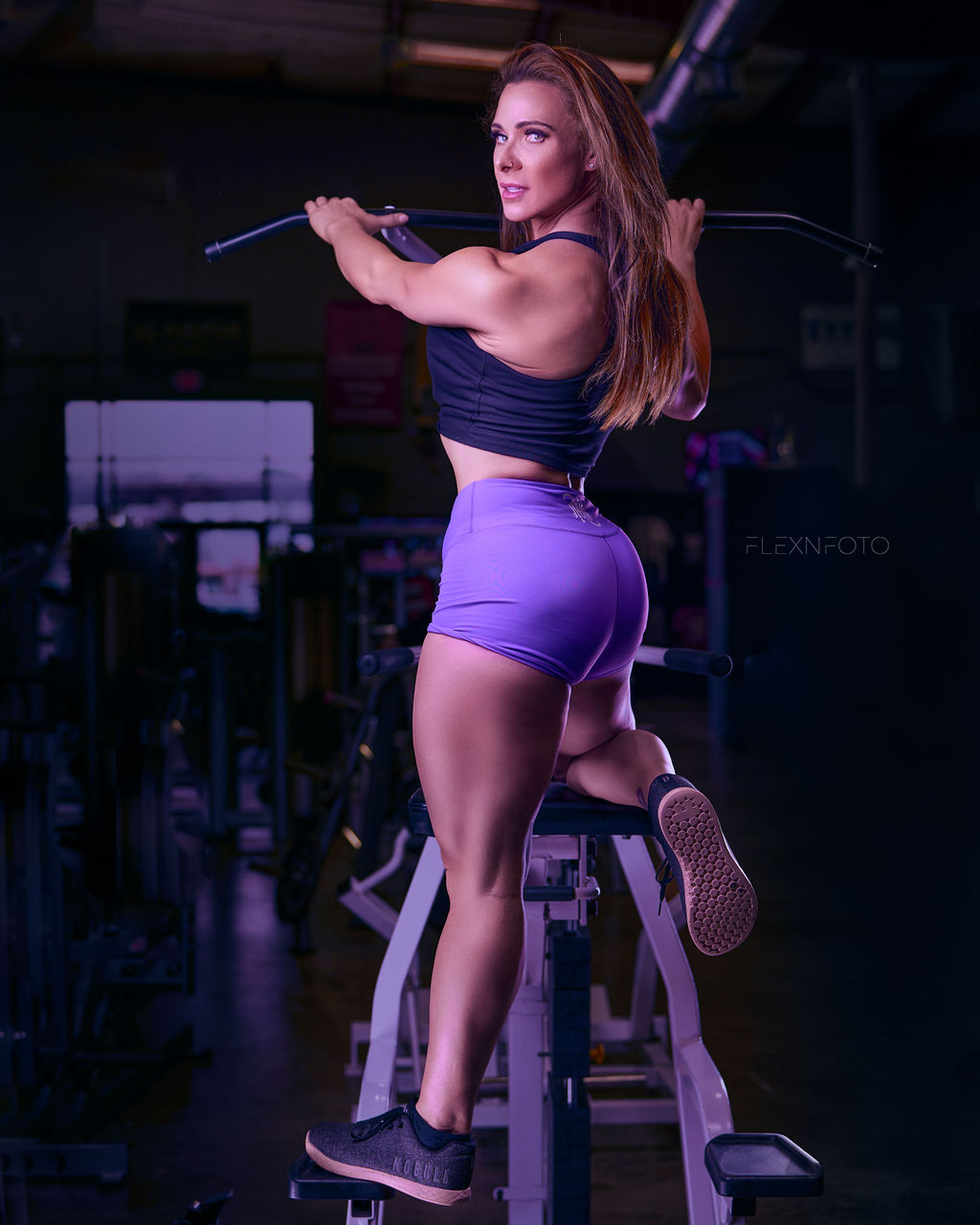Blog
Downward Dog to Deadlifts
Unveiling the Hidden Benefits of Yoga for Strength Training
Welcome, my fellow strength enthusiasts, to the ultimate mashup of brawn and bliss. It is time to grab your barbell and your downward dog because we are diving head-first into the world of strength training and yoga. (Did I just really use both of those words together, in the same sentence?! Heresy!.) But stick with me here. Picture this: muscles straining, deep stretches, and the chanting of “om” meets “Do you even lift, bro?” I am about to teach you the top 5 benefits of adding yoga to your routine. I know it will make you a better lifter.

“Yoga is for people who are already flexible.” This is exactly what I thought for many years, and I am admitting to you that I was completely wrong.
Strength training and yoga? Many think of them as polar opposites. In truth, they’re a match made in heaven. Think of them as that salty-sweet killer taste combination. Strength training brings out the salty pop of power and yoga enhances the sweet feeling of unrestricted movement. Combining the two will help you build your strength and give you the mobility needed to target the exercise’s entire range of motion. This blog is not about debating which one is better but discussing the benefits of including both.
But how does a strength athlete start yoga? By taking the first step of course.
“Training for strength and flexibility is a must. You must use it to support your techniques. Techniques alone are no good if you don’t support them with strength and flexibility” -Bruce Lee
First Step – Understanding Strength Training
Strength training, also known as resistance training, increases muscle strength by applying a force, or weight, to a working muscle. Applying force to a working muscle by strength training can increase strength, hypertrophy, power, and muscular endurance.
Understanding Yoga
Yoga is an ancient and complex practice, originating in India over 5,000 years ago that has now become a popular form of exercise and overall well-being. Yoga is a bodyweight exercise, using your body's force or weight to elicit physical adaptations. Yoga, as practiced in the U.S., involves poses (asanas), breathing techniques (pranayama), and meditation (Dyana). There are many types of yoga from gentle practices such as a restorative practice to a powerful, physically demanding one called power vinyasa.
“Flexibility is like a muscle: the more you use it, the stronger it becomes.”
What can yoga offer to benefit your strength training routine? Well, here are the top five benefits.
1. Improved flexibility.
Strength athletes are focused on shortening their muscles, which we call muscle contraction. Let me ask you a couple of questions: How often do you fully lengthen or fully stretch your muscles? Do you ever feel tight during a lift, especially at the end ranges? I would be willing to bet that you don’t stretch them to their longest capability and, consequently, that you walk around tighter than an extra small shirt on an extra-large body. What happens when you try to force a super-tight shirt over a large mass? It eventually reaches its yield point, or breaking point. It rips. The same thing can happen to tight muscles. The tighter the muscle, the more likely it is to snap when force is applied. Yoga helps to improve the elasticity and overall flexibility of your muscles. If you are too tight to move freely during the entire range of motion, you are not able to load the entire muscle. When you don’t load the entire muscle, you are missing out on developing the maximum amount of strength which that muscle can produce. In other words, less strength gains. Why would you want to leave gains on the table? The solution is simple: Fully shorten the muscle in the gym, and fully lengthen the muscle in yoga. Do that and you can work the muscle in its entirety.
2. Greater range of motion + Use of the entire muscle = More strength output. Enhanced muscle recovery.
Strength training can lead to sore muscles. The whole point and purpose of strength training is to tear muscles down and build them back stronger. The damage to the muscle fibers from training leads to an inflammation response (this is when you are sore) which sends signals to the body to repair and recover stronger than before. Yoga helps that repair and recovery by promoting blood circulation, supporting lymphatic drainage (relives swelling and removes toxins), and taking your body from the high-stress, catabolic state of “fight or flight response” (sympathetic nervous system) to the low-stress, “rest and digest” anabolic state of response (parasympathetic nervous system).
Better recovery means more muscle growth.
3. Mind-Muscle Connection.
Despite what you may have been told, the mind-muscle connection is a real concept. Yoga emphasizes mindful movement. During yoga, practitioners are encouraged to focus their attention on the sensations, alignment, and engagement of their muscles during each pose. This heightened sense of awareness allows one to develop a stronger mind-muscle connection by training the brain to consciously activate specific muscles and consciously release tension in muscles that don’t need to be engaged. (You would be amazed at how hard you’re squeezing muscles during a lift that you don’t need and don’t realize you are engaging.) Why is this important? It’s important because contracting a muscle uses energy. Why waste energy on squeezing a muscle you don’t need at the moment? Save energy and minimize fatigue by releasing it. You will improve your work capacity. I can speak to this from experience: yoga greatly helped me develop my neural pathways to have better mind-muscle connections.
Learn to turn on the muscles you need and turn off the muscles you don’t.
4. Balance and Stability
Yoga poses often involve balancing on one leg, or one arm, or holding other challenging poses. Performing these poses will improve your balance and stability. Stability is a key portion of structural integrity. It provides joint support, allowing you to achieve correct and safe positioning under loads. If your shoulder girdle (joint) is not developed and stable, your risk of a shoulder injury greatly increases. Once injured, it will never heal to be as strong as it was originally. You can’t expect a bridge to support cars if it doesn’t have the correct supporting structure. You can’t expect your shoulder joint to support heavy weight if the stabilizing muscles aren’t developed. Developing your balance and stability can translate to increased performance and a decreased risk of injury, especially in exercises that require major stability in the supporting joints in movements such as the big three (bench, squat, deadlift). You are only one injury away from losing your peak performance.
Good balance and stability produce strong joints throughout life.
5. Breathing
Breath awareness is fundamental to yoga. Have you ever noticed that you inhale and exhale through your mouth during your daily activities and not your nose? News Flash, we are designed to breathe through our noses, not our mouths. Modern living has increased our laziness, not just with our activity level but even how we breathe. Strength training’s general rule of thumb is to inhale through your nose on the eccentric portion and exhale during the concentric portion through your mouth – a habit yoga can build on by syncing types of breathing with movement. Breathing with the movement allows for a more controlled and coordinated movement during exercise. Yoga emphasizes conscious deep breathing patterns which can improve lung capacity, respiratory efficiency, and oxygen uptake. Through these specific breathing techniques, yoga can enhance respiratory muscle strength, increase lung volume, and allow you to have optimal oxygen exchange to fuel your training session (and decrease your risk of chronic fatigue).
The better you breathe, the more you may be able to lift.
Now that you are aware of some major benefits of yoga let me suggest how to incorporate yoga into your strength training.
Strength training is the meat and potatoes of your training; it takes up most of the plate. Consider yoga a side dish that, complements the main course. Perhaps for you, yoga is the vegetable, not the favorite side, but it has a purpose (hip hip hooray for fiber). Yoga must be able to ADD to your training, not take away from it (eat too many vegetables and you have no room left for the meat and potatoes). Building muscle and strength takes up most of your time in the gym and your time to rest and recover. For this reason, doing intense yoga practice may result in a subpar performance in the gym.

Training hard in the gym pairs well with gentle and restorative yoga.
I recommend 2-3x/wk of gentle, stretchy yoga lasting 10 and 20 minutes.
An intense power yoga practice pairs well with rest days.
For this, I recommend no more than 1x/wk, for 45 to 60 minutes total.
If you want to incorporate yoga as a warm-up before your lift, stick to movements that will prepare your body and improve your range of motion and mobility such as downward dog, bird dogs, and cat cow.
Yoga is also a great way to cool down and stretch post-workout. Poses such as seated forward fold, low lunge, and bow pose will help stretch out tight muscles post-workout.
Remember, the integration of yoga and strength training is based on your individual goals. It is essential to listen to your body and adjust the frequency, time, and intensity of both as needed. By adding a yoga practice to your strength training program, you will develop a greater sense of body awareness, control, and unrestricted movement patterns. This will benefit your strength training by optimizing your technique and athletic performance and effectively targeting the intended muscles, leading to increased strength gain and overall performance. We are only as strong as our weakest link.
Allow me to recommend some of the best poses to complement your strength training:
Intense Power Poses:
- Warrior 1 – stretches the lats, calves, hip flexors, and abs. Strengthens the thighs, core, feet, and ankles.
- Warrior 2- stretches the inner thighs, groin, and chest. Strengthens the legs, abs, and arms. Opens the hips and shoulders.
- Warrior 3 – strengthens the stabilizing muscles in the feet and ankles, strengthens the legs, back, and core, improves balance and stability in the whole body.
- Downward-Facing Dog -strengthens the whole body, upper body, arms, shoulders, abdomen, and legs. Stretches the back of the body, ankles, calves, hamstrings, spine.
- Plank Pose - this arm balance strengthens your arms, wrists, core and spine.
- Chair Pose - improves balance and can build cardiovascular health and resilience. It particularly strengthens your core, thighs, and ankles.
- Cobra Pose – increases mobility of the spine, strengthens the muscles that support the spine, and stretches the chest.
Gentle and Restorative Poses
- Child’s Pose - stretch for the shoulders, back, hips, thighs, neck, and ankles. It can help relieve back pain.
- Happy Laughing Baby Pose – stretches back, hips, and hamstrings.
- Waterfall Pose – a restorative inversion, refresh the body with gravity aiding the flow of blood toward the pelvis to induce the recovery process.
- Forward Fold – stretches the hips, hamstrings, calves and provides spinal stretching.
- Pigeon Pose – stretches hip flexor and glutes, increases hip mobility.
- Reclined Butterfly – stretches hips and inner thighs, increases hip mobility.
- Ragdoll Pose – releases tension in the lower back, relaxes muscles of the neck and shoulders, stretches the spine and provides spinal traction.
- Shavasana – also called corpse pose, the final pose of practice. This pose rejuvenates the body, reduces stress and tension.
My favorite yoga studio in Haymarket, Virginia: Transform Power Yoga
- Offers in person and virtual classes
- Obtained my 200-hour yoga teacher training certification here through Yoga Alliance
- Super grippy/nonslip to help you stay grounded during sweaty practices. Plus, this mat is reversible. One side is super grippy for sweat sessions and the other side is cushioned for a gentler practice
- 5mm offers cushion for knees and body (I have tried 3mm and my knees hated me
- Antimicrobial additive (protect yourself from gym and yoga floors)
- Comes in 17 colors
- Blocks provide extra stability and balance needed during a yoga practice
- I don’t practice without one
- Strap helps bridge the gap for stretches we cannot access on our own due to limited flexibility. Think of a strap as a extension of your arm or leg.
My recommendations to learn more about breathing for strength training:
- Breathing for Warriors: Master Your Breath to Unlock More Strength, Greater Endurance Sharper Precision, Faster Recovery, and an Unshakeable Inner Game
- The Oxygen Advantage by Patrick McKeown
- Breath, The New Science of a Lost Art by James Nestor
About the Author

Ashley Hromyak, BS Kinesiology, CSCS, RYT200, TSAC-F is a US Army Veteran, a former airborne paratrooper who’s supported special operations and multiple combat tours, an IFBB professional bodybuilder, Yoga Instructor, and fitness coach. She has been training and coaching since 2007, and owning her own business, Go to Grow Fitness, LLC since 2012. Ashley has her BS in Kinesiology with a minor in coaching, and is graduating with her MS in Kinesiology in December 2023. Certifications: CSCS, TSAC-F, and RYT200.
Email: ashley.n.hromyak@gmail.com
Website: Go to Grow Fitness
Instagram: @ashley___the___amazing__
Facebook: /ashley.hromyak
Best supplements: Metabolic Nutrition Supplements
Ironmaster has been specializing in producing the best home gym equipment since 1978. Check out Ironmaster.com to learn more about our equipment, like our legendary Super Bench Adjustable Weight Bench, the unrivaled Quick-Lock Adjustable Dumbbells, the customer favorite IM2000 Self Spotting Machine (Smith Machine style half rack!), and of course learn how to build a custom package to take advantage of our everyday discount program.

1 Comment
Very true
Thank you for the poses. The combination helps keep the body in tune with itself . Very nicely put. I remember Arnold talking about stretching between lifts always stuck with me . Peace and love Cajun Chris
Christopher Deal, 07/26/2023 21:52:39